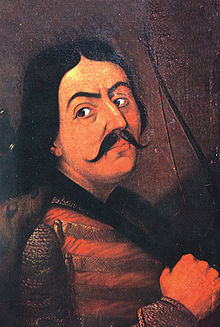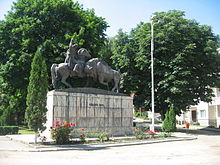- Dragoș
-
Dragoş Voivode in Moldavia 
Dragoş (a 19th-century rendition)Reign c. 1352 c. 1353 Born Unknown Birthplace Unknown Died c. 1353 Place of death Unknown Buried Volovăţ Predecessor None / Unknown Successor Sas Consort Unknown Offspring (?) Sas Father (?) Giula of Giuleşti Mother Unknown Dragoș,[1][2] also Dragoş Vodă[3] or Dragoş of Bedeu,[4] was a Romanian voivode in Maramureş[5] who has traditionally been considered as the first ruler[1] or prince of Moldavia.[4][5][6] Dragos is a common male first name, as well as last name in Romania and Moldova.
According to legend,[7] Dragoş crossed into Moldavia from Maramureş while hunting an aurochs and imposed his rule there, colonizing the territory with Romanians from Maramureş.[6] Altogether he ruled this outpost in the name of King Louis I of Hungary for two years, from 1352 to 1353.[3][8]
Contents
Voivode in Maramureş
In the Moldo-Russian Chronicle, written in the 16th century, Dragoş is considered one of the ‘Romans’ who had gone to Hungary to help a certain ‘King Vladislav of Hungary’ against the Tatars; he was granted territories in Maramureş by the king.[4] In a diploma of the last days of 1336, the boundaries of the lands in Bedeu (Bedevlja, Ukraine) of the brothers Drag and Dragoş were established at the order of King Charles I of Hungary (1308–1342).[4] The document calls them “servants of the king”.[4]
If Dragoş of Bedeu is identical to Dragoş of Giuleşti, as Tudor Sălăgean thinks,[9] he was the son of Giula of Giuleşti (Victor Spinei suggests that Dragoş of Giuleşti cannot be confounded with Dragoş of Bedeu).[4] In 1349, the Maramureş domains of Dragoş of Giuleşti and his family were confiscated by Bogdan[9] (who would later establish the independent Principality of Moldavia).[1]
In the chronicle of the Ragusan Luccari, completed in 1601, Dragoş is designated “barone di Ust, cittá in Transilvania” (“Baron of Hust, a town in Transylvania”).[4] However, the problem of the relation between Dragoş and Hust cannot be elucidated as there is no possibility of checking the truth of Luccari’s assertions.[4]
Dragoş’s ‘dismounting’
The arrival of Dragoş in Moldavia is often referred to in Romanian historiography as the descălecat (dismounting).[5] It is considered by the Romano-Slavic chronicles to be the birth of the Moldavian Principality.[5] This is in keeping with the ritual nature of the chasing of the aurochs.[7]
The territory of the future Moldavia had been under the control of the Golden Horde since the Tatar invasion of 1241.[2] But by the middle of the 14th century the Golden Horde's power was declining, and the Polish-Hungarian offensive against it was at its strongest.[2] The Hungarian military campaigns in the territories east of the Carpathians started in 1343; in 1345-46 important successes were recorded as the Tatars were pushed back towards the eastern Black Sea.[9] At the same time, King Casimir III of Poland (1333–1370) attempted to win territories there, but the Polish army was driven back by Voivode Peter, leader of one of the state formations of this region.[9]
The Anonymous Chronicle of Moldavia relates briefly Dragoş’s ‘dismounting’:[4]
In the year 6867 (1359) Dragoş Voivode came from the Hungarian country, from Maramureş, hunting an aurochs, and reigned for two years.—The Anonymous Chronicle of MoldaviaThe Moldo-Polish Chronicle, written in Polish in the third quarter of the 16th century on the basis of internal annals, gives a more ample description (placing the event, however, in 1352):[4]
By the will of God, the first voivode, Dragoş, came from the Hungarian country from the town and river of Omaramuruş /Maramureş/, hunting an aurochs which he killed on the river Moldova. There he feasted with his nobles, and liking the country he remained there, bringing Hungarian Romanians as colonists and reigned for two years.—The Moldo-Polish ChronicleThe tradition which attributes to Dragoş the quality of single organizer of the foundation of the state is not in keeping with contemporary sources.[4] It may convincingly be asserted that the armed initiative was undertaken by King Louis I and Dragoş was a tool of his policy.[4] However, the fact that he was put at the head of the defensive border province in Moldavia[2] shows that his participation and that of his followers in the military operations east of the Carpathians was important.[4]
The place at which Dragoş “dismounted” and the center where he established his capital preoccupied many researchers.[4] István Vásáry suggests that the centre of Dragoş’s Moldavian voivodeship must have been on the Moldova river and in Bukovina.[5] Tradition links him especially to Bukovina, where numerous place names and legends evoke his name and his deeds.[4]
In 1360, King Louis I granted Dragoş of Giuleşti and his sons 6 villages along the valley of the river Mara.[4] According to the diploma issued on March 20, 1360, Dragoş of Giuleşti had restored “the country of Moldavia” thus “bringing back the revolted Romanians to steadfast loyalty”.[4] As Dragoş of Giuleşti did not remain in Moldavia but returned in Maramureş after the submission of the Moldavian Romanians, Victor Spinei thinks that he is not identical to the founder of Moldavia.
Dragoş was buried at Volovăţ.[4]
See also
- Foundation of Moldavia
- Etymology of Moldova
References
- ^ a b c Klepper, Nicolae. Romania: An Illustrated History.
- ^ a b c d Georgescu, Vlad. The Romanians: A History.
- ^ a b Brezianu, Andrei and Spânu, Vlad (2007) "Dragoş Vodă (?–ca. 1353)" Historical Dictionary of Moldova (2nd ed.) Scarecrow Press, Lanham, Maryland, USA, pages 124-125, ISBN 978-0-8108-5607-3
- ^ a b c d e f g h i j k l m n o p q r Spinei, Victor. Moldavia in the 11th-14th Centuries.
- ^ a b c d e Vásáry, István. Cumans and Tatars: Oriental Military in the Pre-Ottoman Balkans, 1185-1365.
- ^ a b Treptow, Kurt W.; Popa, Marcel. Historical Dictionary of Romania.
- ^ a b Eliade, Mircea (1970) "Chapitre IV: Le Prince Dragoş et La "Chasse Rituelle" (Chapter IV: The Prince and the "Ritual Chase")" De Zalmoxis à Gengis-Khan: études comparatives sur les religions et le folklore de la Dacie et de l'Europe orientale Payot, Paris, pages 131-160, OCLC 301472774; a deep psychological and mythological analysis of the legends.
- ^ Although Spinei gives the years as 1359-1360, the 1352-1353 dates are generally accepted by other authors, such as Niculescu, Alexandru (2005) "Romania Hungarica" Revista Literară Vatra (Vatra Literary Review) 2005(1-2): pp. 116-125 (in Romanian) and Harjula, Mirko (2009) Romanian Historia BoD (Books on Demand), Norderstedt, Germany, page 198, ISBN 978-952-92-5264-0; (in Romanian) and others. The earlier dates are more consistent with other known dates, such as the 1359 date of Bogdan I's overthrow of Hungarian suzerainty. See Deletant, Dennis (1986) "Moldavia between Hungary and Poland, 1347-1412" The Slavonic and East European Review 64(2): pp. 189-211, pages 190-191.
- ^ a b c d Sălăgean, Tudor. Romanian Society in the Early Middle Ages (9th-10th Centuries).
Sources
- Brezianu, Andrei – Spânu, Vlad: Historical Dictionary of Moldova (entry ‘Dragoş Vodă (?-ca. 1353)’);
- Georgescu, Vlad (Author) – Calinescu, Matei (Editor) – Bley-Vroman, Alexandra (Translator): The Romanians – A History; Ohio State University Press, 1991, Columbus; ISBN 0-8142-0511-9
- Klepper, Nicolae: Romania: An Illustrated History; Hippocrene Books, 2005, New York; ISBN 0-7818-0935-5
- Sălăgean, Tudor: Romanian Society in the Early Middle Ages (9th-10th Centuries); in: Ioan-Aurel Pop – Ioan Bolovan (Editors): History of Romania: Compendium; Romanian Cultural Institute (Center for Transylvanian Studies), 2006, Cluj-Napoca; ISBN 978-973-7784-12-4
- Spinei, Victor: Moldavia in the 11th-14th Centuries; Editura Academiei Republicii Socialiste Româna, 1986, Bucharest
- Treptow, Kurt W. – Popa, Marcel: Historical Dictionary of Romania (entry ‘Dragoş (Mid-14th century)’); The Scarecrow Press, Inc., 1996, Lanham (Maryland, USA) & Folkestone (UK); ISBN 0-8108-3179-1
- Vásáry, István: Cumans and Tatars: Oriental Military in the Pre-Ottoman Balkans, 1185-1365; Cambridge University Press, 2005, Cambridge; ISBN 0-521-83756-1
Preceded by
None / UnknownVoivode in Moldavia
c. 1352/1359-c. 1353/1360Succeeded by
SasCategories:- Rulers of Moldavia
- 14th-century Hungarian people
- Romanian people in the history of Hungary
- Maramureş
Wikimedia Foundation. 2010.

